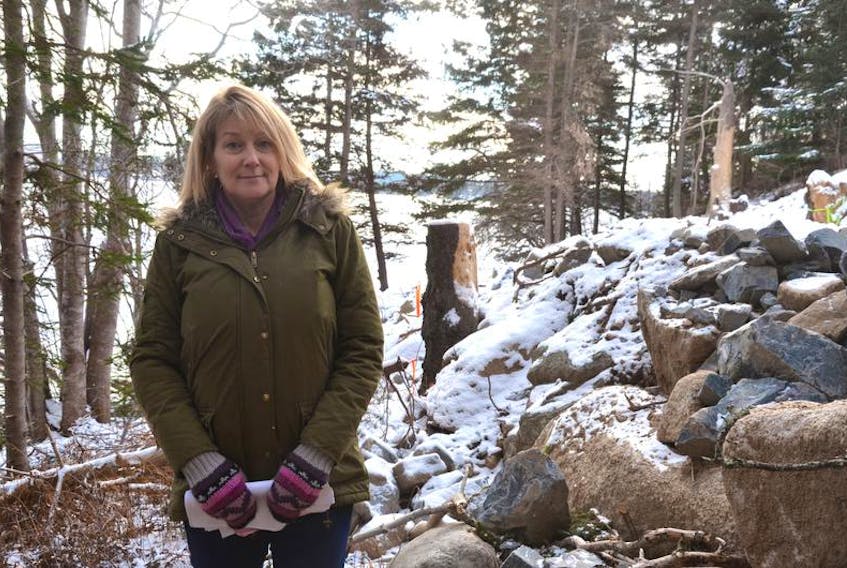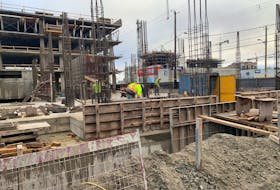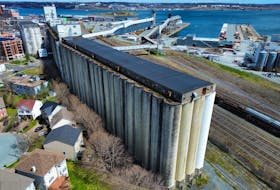Note: Sea levels are rising at a pace unparalleled in modern times and storms are becoming more intense as a result of global warming. This story is part of a weeklong series examining our rising oceans, the impact on our region and what government, scientists and others are doing to track change and mitigate damage.
Click here to read the series.
The Ecology Action Centre’s coastal watchdog has lots on her mind this holiday season.
“The particular issue that we are focused on here is undersized lots,” said Nancy Anningson.
Anningson has her eye on three different lots within Halifax Regional Municipality that are proposed for development. She said a 4,400-square-foot lot at 6566 St. Margarets Bay Rd. that hugs a steep slope between the road and the bay is typical.
“They are long, skinny lots with a roadway going through,” Anningson said. “Traditionally, it was one lot. Over time, these lots have gotten separated and the oceanside lots that are extremely small, with a very steep slope, are being sold for potential development. They are too small and they are not safe. Because they are undersized lots, the municipality interprets the regulations in a different way and they don’t seem to be subject to the setback amounts and the vertical allowances that other pieces of land that are being considered for development along the coast are subject to.”
John Whyte lives a couple of properties down the winding highway from the St. Margarets Bay Road lot Anningson is dwelling on. He said the situation should be a flag for the many similar properties that exist in the province.
“It was kind of a surprise to see a permit granted for a dwelling about 10 to 12 feet from the ocean,” Whyte said. “The septic system will sit about eight to 10 feet above the ocean, 20 feet back on the slope.”
Whyte, who built his home on a much bigger existing lot about a decade ago, contrasts the neighbouring property to a normal building lot, which would have a 20-metre or 66-foot buffer zone from the dwelling to the ocean.
“That buffer zone is intended to be a vegetative zone with no excavation and no infilling and no tree removal. How you get from 66 feet down to 12 feet is kind of baffling. It is my understanding that the 66-foot standard buffer can’t be varied. You’re just not allowed to build within that.”
But the municipality has made some provisions for undersized lots.

“That kind of makes sense,” Whyte said. “These lots would have existed before the rules changed and the (provisions) try to preserve people’s ability to develop them. On the undersized lot, the catch is that HRM, at least, is interpreting the bylaw in a way that buffers can be reduced but there is no public process to review the reduction. If you were building a house on a normal lot and you wanted to move it a foot closer to the road or another property, there would be a public appeal process, a notification process. They currently have what you can almost call a blank cheque to reduce at will the buffer to the ocean. It’s 50 feet closer to the ocean.”
Anningson said she was told by municipal staff recently that undersized lots are not being held subject to any setback amount from the high water mark.
“The only consideration for these undersized lots is their proximity to roadways and property owners can seek a variance to get them closer to the roadway than normally permitted,” she said.
That is exactly what the St. Margarets Bay Road property owner did. The property is zoned mixed use and, in that planning district, a 20-foot front yard distance is required between the road and the front wall of the dwelling. The homeowner requested and was granted an eight-foot variance.
“Traditionally, that piece had vegetation, trees and it is protecting the roadway,” Anningson said of the narrow strips of land across the province that separate roadways from waterways. “We have these provisions in place, both to protect our coastline, which needs to be able to adapt, and to protect our citizens and our properties. Who is responsible if someone builds a home like this and then it completely floods and people are put in danger?”
One of those provisions is the safe vertical allowance, considered to be an elevation of 3.8 metres above the normal high water mark. Neither the dwelling nor the septic field planned for the St. Margarets Bay Road property would be built at that elevation.
“It’s pretty tight but there has been a septic system approved,” Whyte said of the neighbouring lot. “That is not specific to this lot but it’s general that they are being approved. If you think in terms of this 20-metre or 66-foot no-disturb buffer, they are actually doing lots of disturbance, they are actually putting a septic field in that spot. Something seems a little bit inconsistent here.”
Inconsistencies could come from trying to determine what falls under provincial jurisidicton and what is covered by the municipality.
“In a case like this, you purchase the lot, you design the plans for your home, you have to get a development permit and a building permit from the municipality and you get a septic permit from the province,” Anningson said. “If the lot is on wetlands or a watercourse, it falls under a different requirement, which is provincial, and if you are going to infill, you need to get a permit to do something like that on a wetland, that’s a whole different system.
“It’s baffling to work your way through the system.”
Anningson said coastal property owners should be governed by consistent regulation.
“My main concern for all this, other than the ecosystem itself, which is extremely important, is the fact that because this is an undersized lot and there seems to be this loophole or this gap in the regulations, the people who buy an undersized lot may not be given the same protection as everybody else who has coastal property,” she said. “That’s done through a setback from the high water mark and a vertical allowance requirement. These undersized lots don’t seem to be protected by those same measures and they need to be.”
Scanning a map, Whyte estimates there are 25 of the 3,000- to 4,000-square-metre undeveloped waterfront lots near his home and about 100 surrounding the bay.
“You start to look at coastal strategic plans and part of the concern is about density along the water,” Whyte said. “Casting an eye along the bay, you can imagine almost a city-like density.”
Although he feels no personal animus toward his would-be neighbour, Whyte unsuccessfully appealed this fall to community council to stop the property owner from getting the variance required to build. He will seek a judicial review of regional council’s decisions on variance and granting a building permit in a proceeding scheduled to start in Nova Scotia Supreme Court on Jan. 10.
“It would be my hope that something could come out of this that could be far-reaching, beyond this particular case,” he said. “Even if this dwelling goes ahead, it would be good to see this being the last one.”









